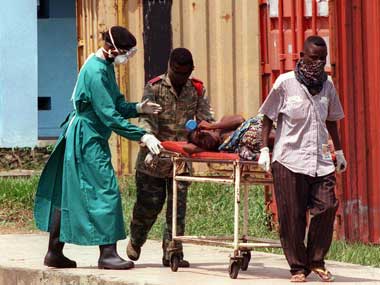By Julia Shen
Ebola’s deadly sweep across West Africa has raised global alarm : Nigeria recently became the fourth country affected by the virus when a traveler fell ill and died in Lagos after flying there from Monrovia. With the Nigerian case, Ebola has entered Africa’s largest economy and a global transit hub, after first emerging in Guinea, Liberia, and Sierra Leone. Amid escalating travel precautions and airline restrictions, deaths of emergency responders , and headlines about national security meetings , we’ve answered a few key questions below to put the risk in perspective.
Is Ebola going to become pandemic?
Probably not.
The situation is quite serious: this is the largest and deadliest outbreak – and the first in this region – since Ebola was first observed in 1976 . The latest CDC notice has officially elevated travel advisory on the three principally affected countries to “Warning Level 3, Avoid Nonessential Travel” although the WHO has not yet echoed this call . As Dr. Ian Mackay has depicted in his Virology Down Under infographic, these figures are equal to almost 90% of cases and 70 percent the total deaths from the first thirty years of Ebola epidemics, combined .
Ebola has no treatment or vaccine , and many of its victims die after multi-organ failure and internal and external bleeding , leading to a fatality of 50-90 percent. Yet the biology that makes Ebola terrifying actually limits its potential as a Hollywood-style superbug . Ebola’s unfortunate victims suffer a few weeks of acute infection very visibly, allowing for rapid identification and containment. The virus incubates for a maximum of 21 days, contrasting sharply with HIV, which patients can have – and pass on – for years without ever showing symptoms.
How does Ebola spread?
Ebola is transmitted by direct contact with bodily fluids. This mode of transmission is dangerous – especially for health care workers – but much less so than a water or food pathway, as with cholera and typhoid. Unlike tuberculosis in cattle or influenza in poultry, zoonotic diseases endemic in us and our livestock that are co-evolving with intensified agriculture , Ebola has previously disappeared from humanity before re-emerging. Filoviridae, the virus family Ebola is a part of, seem to prefer wild bats and apes as a host reservoir . Contradictory to a nightmare mutation scenario, Ebola’s genetic diversity is limited compared to HIV or the flu, and recent experimental evidence suggests the virus is not airborne .
A cornerstone of epidemiology is the basic reproductive number or “R0,” which describes the average number of further infections that a given sick individual will cause. Higher values mean more widespread epidemics. Ebola’s short incubation period and mode of transmission contribute to the virus’ relatively low R0 of 1.9-2.8 in previous outbreaks. Although not precisely comparable across different mathematical models, R0 is a useful benchmark; Ebola’s is much lower than that of measles (12.0-18.0) or polio (5.0-7.0) . The best published model suggests that Ebola’s R0 falls to elimination levels – in which individuals infect
So what’s the appropriate response to Ebola?
Real-world complexities make R0 a moving target. It is conceivable that Ebola will spread farther, including to pockets outside Africa. Recent incidence is worrying, especially in Sierra Leone. Nearly 900 people have died in the eight months since the current outbreak started in rural Guinea .
This visceral danger sells papers. But everyday diarrheal disease killed almost the same number of people in the West African sub-region today alone; malaria killed even more in the same 24 hours. In terms of absolute risk in the affected countries, road injuries still exceed Ebola.
The root causes of mortality from malaria and diarrheal disease also accelerate the spread of Ebola. Post-conflict Liberia and Sierra Leone are among the poorest countries in the world. Despite their natural resource wealth, Guinea and Nigeria have under-resourced health sectors, below the African Union’s 2001 Abuja Declaration health targets . Only $67 – $205 is spent annually per person on health in these four countries affected by Ebola.
A distrust of medicine and lack of health education are worsening the outbreak – infected patients sometimes even flee treatment wards . But suspicion of health services is more understandable in a context where clinics are usually short of qualified staff (Liberia has all of ~60 doctors), drugs regularly stock out , and life expectancy may only be 45 years .
In an age of air travel and worldwide trade, closed borders are simply not a sustainable solution to preventing the spread of diseases such as Ebola: it is not a matter of if, but when, the next disease emerges, potentially as a more dangerous respiratory illness. While more infectious risk is inevitable for a growing human population, however, the histories of smallpox and polio show that massive death and suffering are preventable.
The current Ebola outbreak is not an occasion for panic but should raise an urgent call for public health investment in West Africa and other underserved regions, for our shared global health security . Leadership from national authorities and international partners can curb the economic damages and public anxiety, ending the loss of life from Ebola – and the longstanding pandemics already affecting hundreds of millions of people every day.
The author is a consultant in Dalberg Global Development Advisors ’ Dakar office. This article was reviewed by Dr. Manpreet Singh (MB BChir MPH), also a consultant in Dalberg’s Nairobi office. Dalberg is a strategy and policy advisory firm dedicated to global development. This piece first appeared on Dalberg’s blog on 5 August 2014.


)




)
)
)
)
)
)